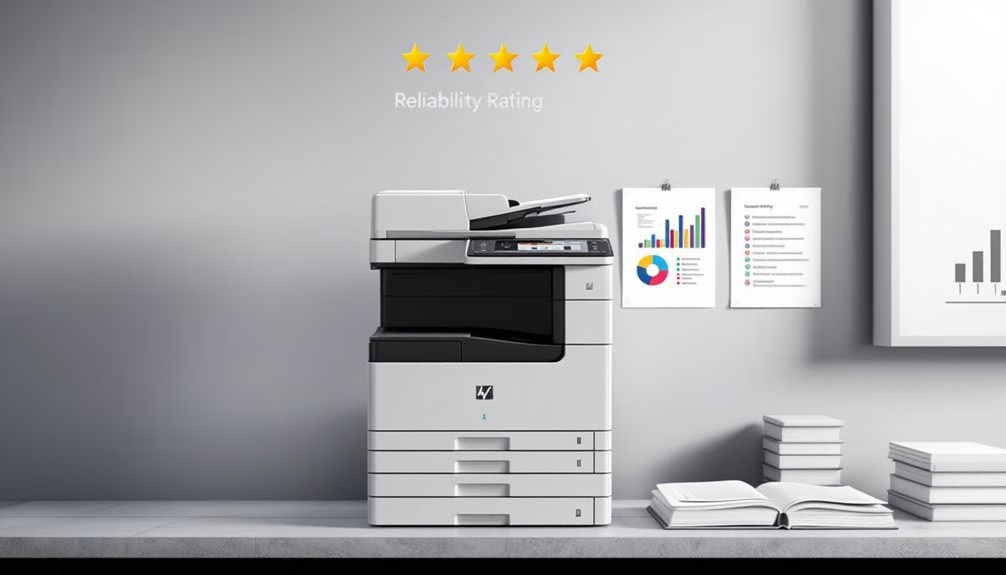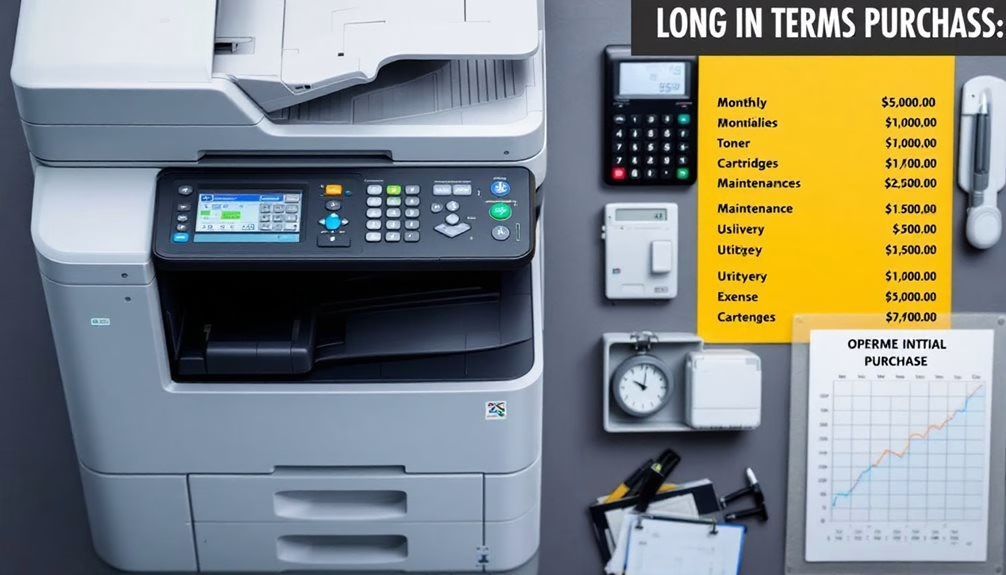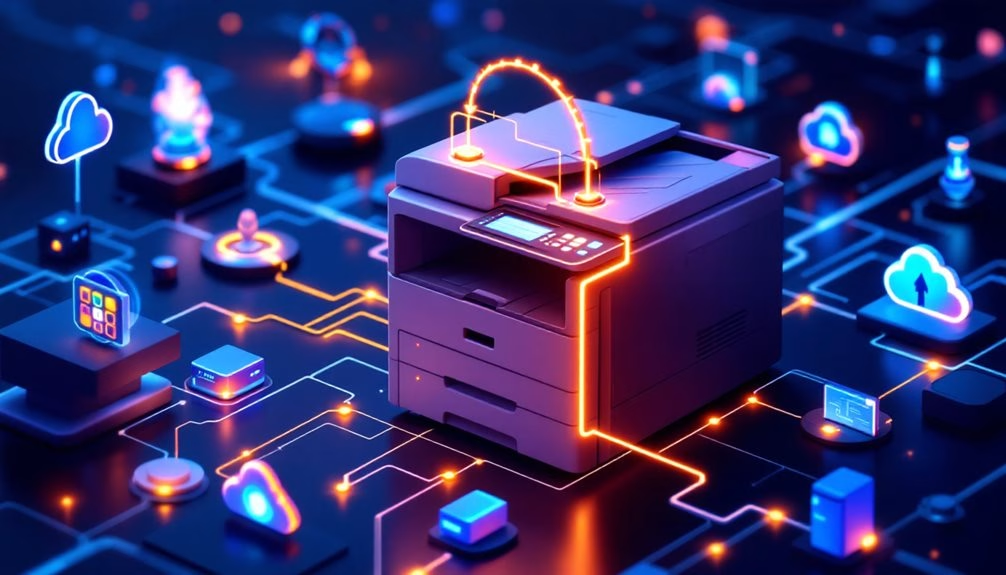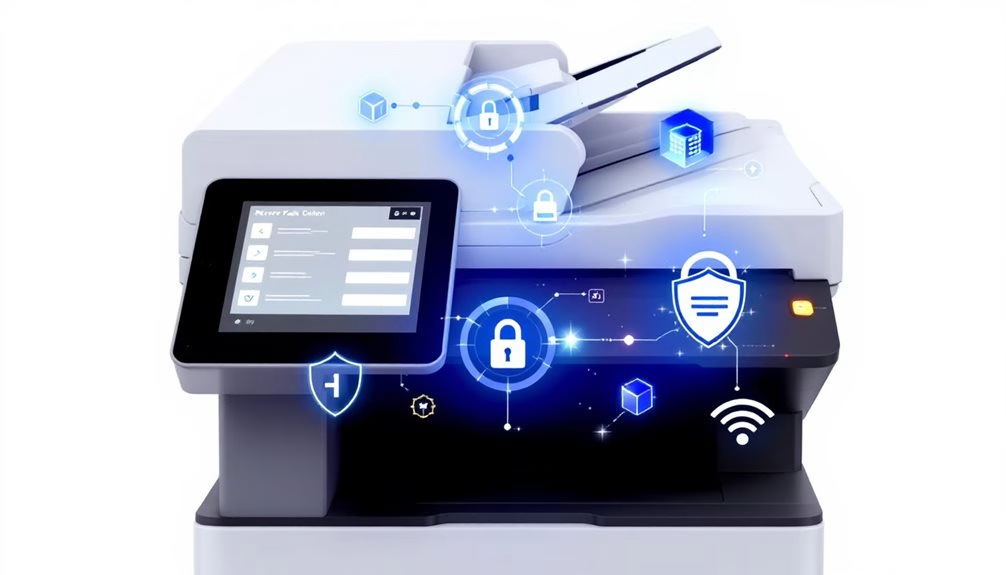When selecting a copier brand, we need to evaluate reliability track records, thorough service infrastructure, and total cost of ownership beyond the initial price tag. We should verify integration capabilities with our existing systems and prioritize strong security features that protect sensitive information. Energy efficiency and sustainable practices are increasingly important considerations too. These key factors will determine your long-term satisfaction and value far more than flashy marketing features.
Expert Highlights
- Evaluate reliability track records and service infrastructure, ensuring availability of local technicians and genuine parts for maintenance.
- Calculate total cost of ownership including service contracts, consumables, and energy costs, not just the initial purchase price.
- Verify integration capabilities with existing systems, supporting preferred connection protocols and cloud compatibility for seamless workflow.
- Prioritize security features like user authentication, data encryption, and automatic updates to protect sensitive information.
- Choose ENERGY STAR certified models with eco-friendly features to reduce power consumption and align with environmental sustainability goals.
Reliability and Performance Track Records

When evaluating copier brands, reliability and performance track records should top your priority list.
We’ve found that examining a brand’s history of dependability can save you countless headaches down the road.
Look for manufacturers with proven longevity in the marketplace and low repair frequencies. We recommend consulting industry publications like Buyers Laboratory or J.D. Power ratings that track performance across brands.
Don’t just take the manufacturer’s word—reach out to peers in your industry. Their real-world experiences often reveal how machines perform under conditions similar to yours.
Our factory-trained technicians provide comprehensive maintenance services that can significantly extend the lifespan and performance of your equipment.
Total Cost of Ownership Beyond Purchase Price

When evaluating copier brands, we must carefully examine service contract details that might include escalating renewal costs or exclusions for critical parts.
We’ll often discover hidden operational expenses beyond the initial purchase price, including power consumption, supplies markup, and software licensing fees.
These ongoing costs can greatly impact your total investment over a copier’s lifecycle, sometimes exceeding the original purchase price by two to three times.
Choosing the right equipment can significantly lower your total cost of ownership by up to 30% through high-yield toner options and energy-efficient operation.
Service Contract Details
Three critical components of service contracts considerably impact your copier’s total cost of ownership beyond the initial purchase price.
First, check response time guarantees—we’ve found anything beyond four hours can considerably impair productivity.
Second, examine what’s covered: parts, labor, and preventative maintenance should all be included without hidden charges.
Finally, assess contract length and termination clauses; we recommend flexibility that allows adjustments as your needs evolve.
When comparing brands, remember service quality often varies by region.
We’re always looking for providers who offer online diagnostics and remote troubleshooting to minimize downtime for your team.
Hidden Operational Expenses
Beyond service contracts, numerous hidden expenses can greatly affect your copier’s long-term costs.
We often overlook these operational elements when comparing brands. Toner yield varies considerably between manufacturers—some requiring replacement twice as often as others.
Power consumption differences can add hundreds to your annual utility bills.
Paper compatibility is essential; some machines handle lower-cost paper without jamming, while others don’t.
Supply chain reliability matters too. Will you face delays getting parts or consumables?
And don’t forget staff training time—intuitive interfaces save countless hours of productivity.
When we evaluate these hidden costs together, the cheapest upfront option rarely remains the most economical choice.
Service and Support Infrastructure

A robust service and support infrastructure forms the backbone of any reliable copier brand.
We’ve found that even the most advanced machines will eventually need maintenance or repair. That’s why we recommend choosing a brand that stands behind their products with exceptional service.
When evaluating service infrastructure, we prioritize:
- Response time guarantees for emergency repairs
- Availability of local technicians in your area
- Quality of technical support via phone and online channels
- Access to genuine parts and consumables
Together, we can select a copier brand that won’t leave you stranded when issues arise. Providing your ZIP/postal code when requesting quotes ensures you’ll be matched with local service providers who can deliver prompt maintenance and support.
Integration Capabilities With Existing Systems

We’ll now examine how well a copier integrates with your existing digital ecosystem.
First, check if the copier’s software is compatible with your current operating systems and applications to guarantee seamless workflow.
Additionally, verify that the machine supports your preferred connection protocols, whether you need wireless connectivity, cloud compatibility, or specific network configurations.
Look for copiers that offer cloud connectivity features which will enhance your team’s ability to access documents from anywhere while maintaining advanced security protections.
Software Compatibility Check
Before finalizing your copier brand selection, conducting a thorough software compatibility check is essential to validate seamless integration with your existing systems.
We’ve found that many organizations overlook this step, only to face workflow disruptions later.
When evaluating compatibility, focus on these key areas:
- Document management system integration capabilities
- Cloud service connectivity (Google Drive, Dropbox, OneDrive)
- Enterprise resource planning (ERP) software compatibility
- Mobile printing app support across your team’s devices
Together, we’ll ascertain your new copier enhances productivity rather than creating technical headaches.
The right brand fits seamlessly into your digital ecosystem.
Connection Protocol Support
How effectively your copier connects with your network infrastructure determines its long-term value for your organization.
We recommend selecting brands that support multiple connection protocols including TCP/IP, SNMP, LDAP, and SMB.
Look for copiers with robust wireless capabilities that accommodate Wi-Fi Direct and near-field communication (NFC).
Today’s top brands offer enhanced API integration, allowing your copier to become a seamless extension of your existing workflow systems.
Don’t overlook cloud connectivity options—they’re essential for teams working remotely.
We’ve found brands with native support for Google Workspace, Microsoft 365, and Dropbox deliver the best experience for collaborative environments.
Security Features and Compliance Standards

Three critical security considerations should guide your copier brand selection.
Security must be paramount when choosing a copier brand, not merely an afterthought.
We’ve found that data protection, network security, and compliance validation represent the cornerstone of modern document management.
When evaluating brands, we recommend verifying these essential safeguards:
- User authentication options – including badge scanning, PIN codes, and biometric verification
- Data encryption standards – both for stored documents and network transmission
- Automatic security updates – ensuring protection against emerging vulnerabilities
- Industry compliance certifications – such as HIPAA, GDPR, or ISO 27001
Managed Print Services solutions can strengthen document security through advanced protection protocols that safeguard sensitive information throughout its lifecycle.
Sustainability Practices and Energy Efficiency
While selecting a copier brand, sustainability practices and energy efficiency have become increasingly essential considerations for environmentally conscious businesses.
We recommend looking for ENERGY STAR certified models that reduce power consumption and lower utility costs. Many leading brands now use recycled materials, offer recyclable toner cartridges, and design machines with eco-modes that automatically power down when idle.
We’re also seeing manufacturers tout their carbon footprint reduction initiatives and sustainable supply chains.
Frequently Asked Questions
How Long Should a Copier Last Before Needing Replacement?
We expect our copiers to last 5-7 years with regular maintenance. Your usage volume and care routine will impact longevity, so let’s follow the manufacturer’s recommended service schedule.
Can I Lease a Copier Instead of Purchasing Outright?
Yes, you can lease a copier! We highly recommend this option for many of our clients. Leasing offers flexibility, predictable monthly payments, and easier upgrades when technology improves.
What Speed Specifications Should I Prioritize for My Office?
We recommend prioritizing pages per minute (PPM) that match your workload. For most offices, 30-45 PPM works well, but busier environments might need 50+ PPM speeds for efficient workflow.
Is a Multi-Function Printer Better Than a Dedicated Copier?
We recommend multi-function printers for most offices since they save space and money while handling various tasks. Dedicated copiers shine only when you’re primarily copying at high volumes regularly.
How Much Physical Space Is Needed for Industrial Copiers?
We need to allocate substantial space for industrial copiers—typically 4-6 square feet for the machine itself, plus additional clearance for maintenance access, paper storage, and operator workspace.
Expert Final Thoughts
When selecting a copier brand, we’ve seen that it’s not just about the price tag. We need to evaluate reliability records, total ownership costs, support quality, system compatibility, security features, and sustainability practices. By carefully considering these factors, we’ll find a brand that meets our operational needs, protects our data, and aligns with our environmental values—making our investment truly worthwhile.
About the Expert
Rafael M.
CEO of JR Copier
With over 35 years of hands-on experience in the copier and office printer industry, Rafael brings unparalleled expertise to every client interaction. His journey from service technician to CEO provides him with comprehensive understanding of all aspects of the business.
Areas of Expertise: Copier and printer sales, equipment leasing strategies, maintenance solutions, and managed print services. Rafael's deep industry knowledge ensures clients receive expert guidance, transparent pricing, and exceptional service for all their office equipment needs.
Connect on LinkedIn